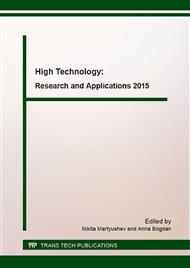[1]
N.B. Skorokhvatov, V.V. Glukhov, V.S. Smornov, Study of possible decrease of formation of surface defects during rolling at Mill 2000, Rolling. 8 (2005) 43-48.
Google Scholar
[2]
I.P. Shabalov, Industrial investigation of transition of steel from lateral faces of a slab onto upper surfaces of a rolled strip, Rolling production. 9 (2004) 3-12.
Google Scholar
[3]
F. Czerwinski, J.Y. Cho, A. Brodtka, A. Zielinska-Lipiec, J.H. Sunwoo, J.A. Szpunar, The edge-cracking of AISI 304 stainless steel during hot-rolling, Journal of materials science. 34 (1999) 4727-4735.
DOI: 10.1023/a:1004670602478
Google Scholar
[4]
N. Yukawa, Simulation of generation process of seam defects in plate rolling, CAMP-ISIJ. 15 (2003) 1006-1012.
Google Scholar
[5]
I. Takashi, Y. Nobuki, Y. Yoshinori, Deformation analysis of surface defects during plate rolling, Tetsu to Hagane. 89 (2003) 1142-1149.
Google Scholar
[6]
L. Gulova, M. Zemko, M. Vlado, T. Lászlo, Simulation of production of selection defects in the rolling process, Acta Metallurgica Slovaca. 14 (2008) 233-239.
Google Scholar
[7]
E. Ervasti, U. Stahlberg, Transversal cracks and their behavior in the hot rolling of steel slabs, Journal of Materials Processing Technology. 101 (2003) 312-321.
DOI: 10.1016/s0924-0136(99)00481-1
Google Scholar
[8]
A. Kainz, E. Parteder, K. Zeman, From slab corner cracks to edge-defects in hot rolled strip – experimental and numerical investigations, Steel Research International. 79 (2008) 861-867.
DOI: 10.1002/srin.200806211
Google Scholar
[9]
A. Pesin, V. Salganik, D. Pustovoitov, Modeling of surface crack form change in continuously cast slabs during roughing rolling at 2000 mm wide strip mill, Proceedings of the 13th International Conference METAL FORMING 2010, 82-86.
DOI: 10.1063/1.3457534
Google Scholar
[10]
A. Pesin, V. Salganik, D. Pustovoitov, Transverse crack modeling of continuously cast slabs through finite element method during roughing rolling at a wide strip mill, Proceedings of the 10th International Conference on Numerical Methods in Industrial Forming Processes NUMIFORM 2010, 1309-1315.
DOI: 10.1063/1.3457534
Google Scholar
[11]
M.S. Chun, H.D. Park, Improvement of the edge seam by using the shape roll at a hot strip mill, Posco technical report. 10 (2007), 56-63.
Google Scholar


